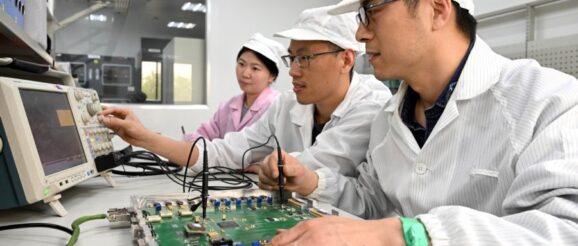Innovation seen as key to breaking China’s industrial bottlenecks

BEIJING – Innovation: Anhui bets big on industries of the future
China’s efforts to promote independent innovation will accelerate the construction of a modern industrial system, which will help the country counter external curbs on crucial technologies, said industry experts and company executives.
They made the comments as East China’s Anhui province, for decades overshadowed by coastal regions, emerges at the forefront of technological innovation by achieving breakthroughs in artificial intelligence, quantum computing, new energy and many other future industries.
Fu Baozong, director of the industry department at the Beijing-based Academy of Macroeconomic Research, which is part of the National Development and Reform Commission, the country’s top economic regulator, said: “Prioritizing innovation will consolidate China’s advantages in traditional industries and at the same time speed up breakthroughs in core technologies for a modern industrial system. It will further enable the country’s industrial development to be strong enough to withstand external risks and challenges.”
His comments echo President Xi Jinping’s remarks during his inspection of Anhui in 2020, where he emphasized that for Anhui, innovation is key to leapfrog development. Xi has also emphasized on various occasions this year that high-level self-reliance and strength in science and technology are key to Chinese modernization.
Anhui might not seem like another Silicon Valley, but it has seen great scientific and technological innovations. It aims to build China’s own global technology and innovation center for modern industrial development.
The center, known as USTC Silicon Valley, was set up in Hefei, capital city of Anhui, last year. USTC, or the University of Science and Technology of China, the Anhui provincial government and Hefei municipal government are the founding partners. Together they will invest in and support global talents to incubate their tech breakthroughs at the center.
Wu Hailong, chairman of the service platform company of USTC Silicon Valley, said: “The soul of the valley is to innovate in the system and mechanism for entrepreneurship, and to bring together forces from the government, university and research institutes as well as companies.”
“Ideally, a scientist can do research and development, incubate ideas into a business, find partners, start a company, cooperate with industrial chain providers all in a single building in the valley,” Wu said, adding that the government wants to make each building in the valley an “innovation consortium”.
By 2025, the valley is expected to gather more than 100,000 high-level talents from across the world, form a diversified funding system with over 200 billion yuan ($29.86 billion), nurture 1,000 high-tech enterprises and more than 50 listed firms and unicorns.
Zhang Lianqi, a member of the Standing Committee of the National Committee of the Chinese People’s Political Consultative Conference, said: “To build a modern industrial system, there must be a group of world-class enterprises that are developed and led by innovation. Only through innovation can Chinese companies occupy a dominant position in the global industrial competition, and form the right to speak on the global stage.”
A case in point is voice recognition software firm iFlytek based in Hefei. The company unveiled in May its own artificial intelligence language model called SparkDesk to challenge the United States’ ground-breaking chatbot ChatGPT in education and enterprise uses.
Liu Qingfeng, chairman of iFlytek, said: “It is expected that the large model will surpass the current level of ChatGPT in Chinese understanding and match the OpenAI chatbot’s capabilities in English by October.”
Before that, the model will go through three rounds of key technical upgrades, Liu said, claiming that it has already outperformed ChatGPT in text generation, knowledge-based questioning and answering, and mathematical ability.
Hu Yu, senior vice-president of Geovis Technology Co Ltd, a Beijing-headquartered digital earth solutions provider, said: “Driving technological innovation will make a huge impact. The commercial aerospace sector, for instance, has incorporated technologies like big data, artificial intelligence and deep learning and will empower China to gain a lead in the next round of technological revolution.”
Looking into the future, Anhui is also betting big on strategic, emerging industries for long-term innovative development. The local government has outlined several future industries, including new energy, in its development plan during the period covered by the 14th Five-Year Plan (2021-25).
Developing future industries was also emphasized by President Xi during the two sessions—the annual meetings of the National People’s Congress, the top legislative body, and the CPPCC, the top advisory body, in March, where he said that strategic capabilities in emerging fields must be bolstered in pursuit of new advantages in national development and international competitions.
Pan Wang, secretary of the board of leading power battery firm Gotion High-Tech, said: “The company will continue to map out industrial chains on a global scale, beef up research and development, and make innovations on core technologies, so as to boost China’s new energy competitiveness on the global stage.”
Wang Zhen, deputy head of Shanghai Academy of Social Sciences, said: “Gathering different innovative factors will make a huge difference. Inland regions of China may have the opportunity to be emerging centers for innovation and entrepreneurship, in the same manner as Silicon Valley.”
The post Innovation seen as key to breaking China’s industrial bottlenecks appeared first on Asia News Network.
